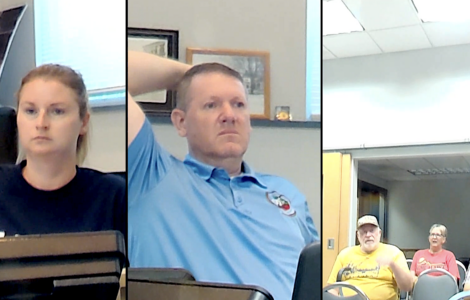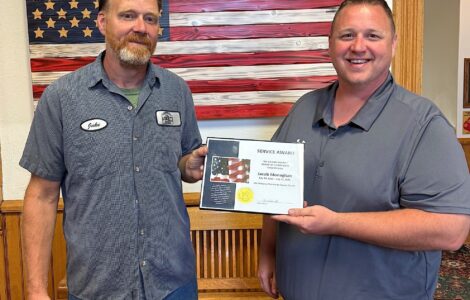Rural superintendents worry about long-term impacts of Students First Act

Gov. Kim Reynolds signs the “Students First Act,” legislation es- tablishing a private school scholarship program into law on Jan. 24 at the Iowa State Capitol in Des Moines after it passed in the early hours that day. PHOTO BY ROBIN OPSAHL/IOWA CAPITAL DISPATCH
The landscape of Iowa education changed considerably this past week after the Iowa legislature quickly voted to pass the Students First Act, a long awaited piece of legislation sought after by Gov. Kim Reynolds, who promptly signed it on Tuesday, Jan. 24.
The law creates Educational Savings Accounts (ESAs), which use taxpayer funds, estimated at $7,598 per student, to supply private school scholarships to all eligible K-12 students in the state.
While the first two years of the program would restrict the availability of the program according to economic status, by the third year, ESAs would become universally available to all students and families, regardless of income, at an estimated cost of $341 million per year according to the Governor’s office.
“Public schools are the foundation of our education system and for most families they will continue to be the option of choice, but they aren’t the only choice,” Governor Reynolds said in a press release after the signing of the legislation. “For some families, a different path may be better for their children. With this bill, every child in Iowa, regardless of zip code or income, will have access to the school best suited for them.”
While Reynolds touted public schools as essential to education in Iowa, public school administrators, particularly those in less densely populated rural areas, have lingering doubts and worries about the future of public education in Iowa.
Among many others, a chief concern for some rural public school administrators is not only the lack of private schools operating in rural Iowa, but the fact that private schools themselves can be selective in allowing which students attend their institutions.
“There are very few private schools available to rural families,” BCLUW Superintendent Ben Petty said in an interview on Monday. “I also see this as another shift of resources and funds from more rural areas to more urban areas in the state. That certainly concerns me, and the equity piece is big for me too, because public schools have to take in and serve all students. Whereas, these private schools don’t have to follow those rules, and they can pick and choose who they’re going to bring in.”
East Marshall Superintendent Anthony Ryan put forth the same concerns, worrying about future disparities in education for Iowa students.
“This is going to widen the gap between the haves and the have nots,” Ryan said. “Private schools can say no to any students that they want, but yet we’re using public taxpayer dollars to support the private schools where public schools do not have that flexibility, nor are we asking for it. We want to accept every student and help every student because that’s what we do in Iowa public education, but it’s going to widen the gap and challenges.”
Additionally, the new $341 million dollar program may potentially be parlayed with the Iowa Republican Party eyeing possible cuts to property and income tax, and Petty feels that the combination will leave public schools with very little recourse for future funding.
“Adding massive new public programs, while you’re also making moves to reduce state revenues, when it comes to the different tax bases, I think is going to be very concerning when we look at the amount of funds that are going to be available to public schools going ahead,” he said.
Already faced with a lack of available teachers and dwindling enrollment in rural Iowa, Petty said BCLUW has been forced to make certain financial decisions in order to keep current educators, and hopefully draw more into the district, without additional funds coming from the state.
“We started tapping more into our reserves in this current school year, and we probably will be doing more so next year in order to try and incentivize our staff to stay and hopefully, for new teachers to consider coming to rural Iowa, and so unless we can really get some new, meaningful resources from the state, that’s going to continue to be a big problem,” Petty said. “To put it bluntly, those are funds that certainly could be going to public schools instead, where over 90% of Iowa’s students actually go to.”
Ryan sees the Students First Act as another step in an alarming avenue in which education in Iowa is headed down.
“I think when it comes to educating, by and large, children in the state of Iowa, I think this is a very slippery slope, a very dangerous path that we’re going down,” Ryan said. “How this is truly going to play out, we won’t know for a good decade, how much damage this is going to do.”
Despite the troubling outlook, both Ryan and Petty indicated that public schools will continue to do what they have always done regardless of future uncertainties; serve the countless different students who walk through their doors each morning.
“Public educators will make it work,” Ryan said. “They always do.”




